More than 337,000 acres stretch across central-Eastern Utah to create the natural geological structures and ecological cultures. President Lyndon Johnson signed an act that made Canyonlands Nation Park land in 1964, and it features previous dwelling from the Paleo-Indian and Archaic people who populated the area around 5,000 B.C.
Features of the Park
The park was once called home by a variety of Native American cultures from the Paleo-Indian and Archaic cultures to the Fremonts and Ancestral Puebloan (Anasazi) people. These occupants hunted large game and edible plants within the area; they also cultivated the land with corn and other grains. Many of the remains and ruins of these cultures still stand in Canyonlands. One such remain is “The Great Gallery,” which features well-preserved, life-sized human figures in the rock walls. The National Park Service features an excellent guide on the archeology of a good guide Horseshoe Canyon art.
Hikers can access these ruins by a variety of trails within the park, including the Aztec Butte Trail, Horseshoe Canyon, Pictograph Fork to Harvest Scene, the Roadside Ruin trail, and the Upper Salt Creek. These trails vary in how strenuous the hike can be. Although the wildlife within the park comes out mainly at night, it isn’t unusual to spot bighorn sheep, red-tailed hawks, golden eagles, peregrine falcons and turkey vulture.
Adventurous Activities
The Green and Colorado rivers cut through Canyonlands National Park splitting it into four regions: the Island in the Sky, the Needles District, the Maze District, and Horseshoe Canyon. Each region provides plenty of activities for visitors. Canyonlands offers a variety of mountain biking trails from March through November.
Several trails are available within the Needles District ranging from six miles to more than 100 miles. The Elephant Hill Access Road provides an easy bicycling experience that takes approximately one hour round-trip. For the more experienced mountain biker, there is Panorama Point and Cleopatra’s Chair that is rated difficult. This trail stretches 21 miles and will take bikers about a day to travel.

Boating and fishing are also available for visitors to the park. There are both peaceful and adventurous boating opportunities in both the Green and Colorado rivers. The Colorado River boasts challenging white water rapids within the Cataract Canyon where individuals can go rafting and kayaking.
Carp, catfish, sand shiners, red shiners, and fathead minnows are the predominant fish found in the muddy rivers within the park. Visitors who chose to fish must purchase a Utah State fishing license. There are also a variety of endangered fish within the rivers, including squawfish, razorback sucker, humpback chub, and bonytail chub; because these fish are endangered, it is asked that individuals fishing in the area release these species back into the river.
In addition, individuals can go rock climbing in the Island in the Sky District. Permits are not necessary for climbing. There is a list of regulations regarding climbing within Canyonlands National Park that can be found here.
Visitors are asked to follow all the rules and regulations within Canyonlands National Park during their stay.






